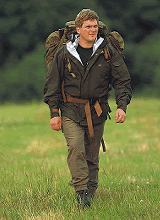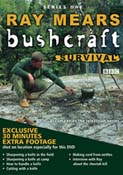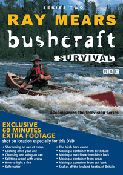Granny's Country Store > Wilderness Survival > Ray Mears Bushcraft | Search | View Cart

Ray Mears Bushcraft DVDs
Bushcraft Survival | Extreme Survival | Walkabout | Wild Food
Reviewed by Thomas J. Elpel
Ray Mears is one of the world's most recognized personalities on wilderness bushcraft and survival. He has a down-to-earth approach, an obvious love for his subject, and empathy and respect for indigenous peoples and their cultures. Mears grew up in the countryside of southern England, in an area rich with wildlife, where he learned to track foxes in the forest. Unable to afford camping equipment, he learned to make do with what he had.
His judo teacher in school, a veteran of World War II, encouraged Mears to challenge conventional wisdom and practices, telling him he needed knowledge, rather than equipment to survive in the wild. Mears digested every scrap of information he could find about survival in his local library and began to discover skills that hadn't been used in his part of the world for millennia. As an adult he has traveled abroad, meeting indigenous peoples and accompanying them while hunting, tracking, and searching for wild plants for food and medicine. Mears founded Woodlore, School of Wilderness Bushcraft in the UK in 1983. His passion is to teach wilderness bushcraft as an encompassing study of nature that transcends cultural and linguistic differences.
Bushcraft Survival Series I and II DVDs
Bushcraft Series I & II is a compilation of ten shows (five in each series) that were filmed by the BBC. These are among the most professionally filmed bushcraft and survival videos ever produced, and they are a real pleasure to watch. However, none of the videos covers "real" survival, since Mears packs along quite a bit of gear. He definitely likes his tarps and cords and cooking pots and knives. Although the film crew is not directly visible in the videos, the fact that there is a large entourage with Mears does occasionally become apparent. There are also times when one has to wonder if Mears truly knows primitive bushcraft at all, or if he just knows tarps and knots. But when Mears uses a knife and makes something with wood, whether it is a willow-framed buffalo-skin bullboat in America, a canoe paddle in Canada, or a cutting board in the UK, it is evident that he is truly competent at what he does. While it isn't clear why a person would need to whittle a fancy cutting board in the woods, it is impressive to watch this and the many other skills presented. I have certainly learned something from everyone one of the videos.
Bushcraft Series I includes the following programs:

- Aboriginal Britain - Learn how our ancestors used the resources around them to feed and clothe themselves.
- The Yekuana, River People Of The Amazon - Mears sets up a jungle camp and sees how the Yekuana live in harmony with their environment.
- The Lost World Of The Pemon - Mears journeys to the huge rock outcrops which inspired The Land That Time Forgot and The Lost World.
- Camping With The Hadza - Mears spends time in northern Tanzania among one of the last hunter-gatherer tribes on the planet.
- Masai Safari - Mears fulfills a childhood dream by experiencing a true safari, Masai-style.
Additional footage covers sharpening a knife in the field, sharpening a knife at camp, how to handle a knife, cutting with a knife, making cordage from nettles and an interview about the cheetah-kill filmed in Tanzania.
Bushcraft Series II includes the following programs:

- Birch Bark Canoe - Ray Mears with Algonquin canoe maker Pinock Smith in Canada, one of the few people left who know how to craft birch bark canoes using traditional methods.
- Canoe Journey - The canoe is the most natural way to travel and get close to wild life in wild places. Mears paddles down the Missinaibi River, a river as unspoiled today as it was three hundred years ago when it was the essential route for the fur trade canoes.
- America - Mears takes a journey into America's past as he travels in the footsteps of Jim Bridger, one of the mountain men who opened up the route to the Pacific Coast of America. He makes a bull boat using willow and buffalo skin and spends time with the Shoshone.
- Sweden - A country where the ancient skills of Bushcraft are alive and in daily use. Lars joins Ray Mears to share the campfire and discuss some of the Swedish traditions and to cook a salmon. He shows how pine tar is made and used on traditional skis before spending time with the Sami people and Yana sings for us.
- Four Seasons - Bushcraft becomes a tool to provide a new perspective to the UK countryside and its changing seasons.
Important Note: While the DVD encoding is for "All Regions", the movies are in PAL format, which will not play on all USA DVD players. If these videos do not play in your DVD player, then try playing them in a computer with DVD capability.
-Please scroll down the page for the "Add to Order" button.-